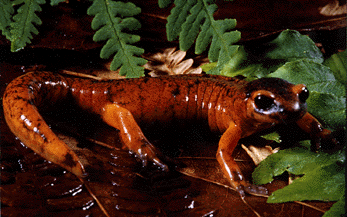Breathing can only be studied indirectly in extinct groups of stegocephalians, but we can infer that most had lungs, like lungfishes, some actinopterygians (Polypterus), and most tetrapods. In addition to this, some groups had larvae with external gills (temnospondyls, seymouriamorphs), although the adults appear to have lost these structures. Cutaneous respiration may have been possible in a few groups, but it was probably not widespread because many stegocephalians were too large for this mechanism to work well, and most were covered in bony scales that would have interfered with gas exchange.
Most tetrapods breathe with the lungs that they inherited from their sarcopterygian ancestors (lobe-finned fishes such as the coelacanth and lungfishes). However, other respiratory structures also exist in lissamphibians, and a few salamanders have even lost their lungs (Duellman and Trueb, 1986). Other respiratory structures include external gills (present in several salamanders and larval amphibians), the skin (in many lissamphibians), and the buccopharyngeal cavity (in some frogs). Amniotes have fewer respiratory structures, but some turtles can use buccopharyngeal breathing to remain submerged for long periods of time (Goin, Goin, and Zug, 1978).


Figure 1. The plethontid salamander Ensatina eschscholtzi. Plethodontids have no lungs; their gas exchange is accomplished by buccopharyngeal and cutaneous breathing. Picture copyright © 1996, Charles Brown.




 Go to quick links
Go to quick search
Go to navigation for this section of the ToL site
Go to detailed links for the ToL site
Go to quick links
Go to quick search
Go to navigation for this section of the ToL site
Go to detailed links for the ToL site